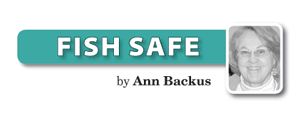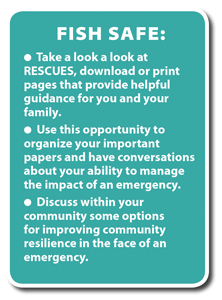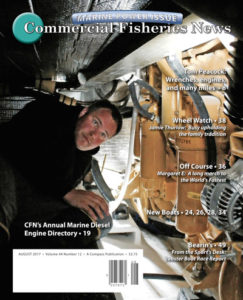A previous Fish Safe article in CFN (Mar. 2016) described the then newly released RESCUES manual.
The first edition of “Responding to Emergencies at Sea and to Communities under Extreme Stress” was developed with assistance from the members of the coastal communities of Gloucester and New Bedford, MA and Point Judith, RI.
The second edition, now hot off the presses, is an adaptation that reflects the specific issues of the lobster fishery in Maine and New Hampshire.
For example, The Canadian Institut de recherche Robert-Sauvé en santé et en sécurité du travail (IRSST) gave permission to lead author Madeleine Hall-Arber to excerpt key concepts from their video identified as the “tricks of the trade” that help lobstermen avoid falls overboard (Appendix E p. 77).
 And I have added a short article on “Reducing the Rope Hazard” (Appendix F p. 81) that many of you will be familiar with.
And I have added a short article on “Reducing the Rope Hazard” (Appendix F p. 81) that many of you will be familiar with.
The pictures, contributed from the Mane Sea Grant collection, represent coastal scenes familiar to those of us who frequent the northern New England coast.
The major adaptation for Maine and New Hampshire is the extensive references section, Community Profiles and Contact Information (Appendix G pp. 85-129), that contains information and contacts for relevant service organizations, presented in four sections:
• Coastal New Hampshire,
• Southern Maine,
• Mid-Coast Maine, and
• Downeast Maine.
We are grateful to the National Office of Sea Grants for providing Community Resilience funds for this adaptation.
What is RESCUES anyway?
When we actually take a deep dive into what we need to do to prepare for an emergency, get through it, and recover in the days, weeks, and months afterwards, there is a lot to take in.
This manual covers:
• What needs to happen on land, at home – knowing the location of the bank accounts, the pin numbers and passwords, the insurance papers, the mortgage documents, the will and other legal documents, etc.;
• What needs to happen on the dock – a float plan, sharing of emergency contact information, preparation of sealed envelopes containing personal health information (one to be left at the dock and one to be given to the medevac team, checking-out communications equipment and EPIRBs, ensuring the availability of a substantial first aid kit, and many more, plus
• Vessel repair and readiness, as well as knowledge of safe practices and emergency response, are also covered.
Chapter 2, the “At Sea” chapter, covers potential dangers at sea: weather, fire, flooding, toxic gases, collisions, tangled gear, fatigue, falls overboard, etc. and finishes with responses fishermen can take in an emergency.
In many cases, because we (fortunately) have not experienced an emergency at sea, we have little knowledge regarding how things proceed once an emergency is in progress.
Chapter 3 is helpful for both fishermen and their families because it sets out what the role of the Coast Guard is and how the community organizations interface with that role.
Helpful hints such as having the family designate one person as the family spokesperson can take some of the pressure off the family, and help ensure consistent messaging among the parties.
This chapter makes clear that there are also numerous steps that communities as a whole can take to lessen the impact of a particular emergency.
My favorite example comes from discussions I had in Point Judith where I learned that the docks were not labeled and that the fire department had no maps of the dock system. Precious time could be lost should the fire responders not be able to locate the fire.
Ideally not only a map of the docks, but one that includes what hazardous materials such as gas, diesel, transmission oil and ammonia, might be present on the docks or in the boats should be available to the harbormaster and the community’s emergency responders.
Community resilience
 The goal of the RESCUES manual is to provide a blueprint to help fishermen and their families be better prepared, not only for fishing-related emergencies, but for any emergency, and to encourage communities to develop the infrastructure and interdependence among organizations that support a coordinated and well-thought-out response at the outset and for the long term.
The goal of the RESCUES manual is to provide a blueprint to help fishermen and their families be better prepared, not only for fishing-related emergencies, but for any emergency, and to encourage communities to develop the infrastructure and interdependence among organizations that support a coordinated and well-thought-out response at the outset and for the long term.
Emergencies and disasters get resolved, but almost always leave physical, social and psychological scars that linger and need to be addressed.
A resilient community is one that is prepared for and can respond to the initial punch, and that recognizes that a number of other layers of services may be needed to bring the community back to some semblance of wholeness.
For a screen version or printable copy of RESCUES: Maine and New Hampshire visit <https://cdn1.sph.harvard.edu/wp-content/uploads/sites/82/2012/09/RESCUES_Maine-and-New-Hampshire-screen-version.pdf>.
Ann Backus, MS, is the director of outreach for the Harvard School of Public Health’s Department of Environmental Health in Boston, MA. She may be reached by phone at (617) 432-3327 or by e-mail at <abackus@hsph.harvard.edu>.
To get these complete stories and much more, you’ll need to purchase the AUGUST 2017 issue of Commercial Fisheries News.
Please choose from the following options:
• BUY a Single PRINT edition of CFN that is delivered by MAIL. PRINT EDITION
• Quickly enjoy ONLINE access with our Hi-DEF flip-book. PURCHASE THIS ONLINE EDITION
• Shop the Online ARCHIVE
(Read online flip-book immediately with purchased access key and download a copy for yourself to keep. Not sure if it works for you? Try a FREE SAMPLE HERE.)
• SAVE BIG when you SUBSCRIBE!







